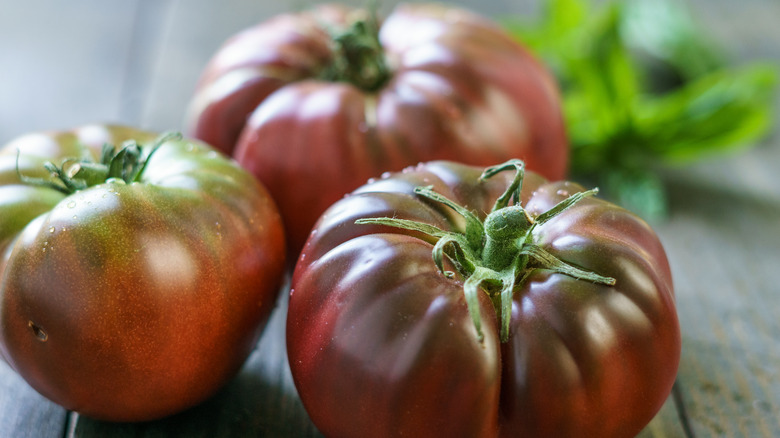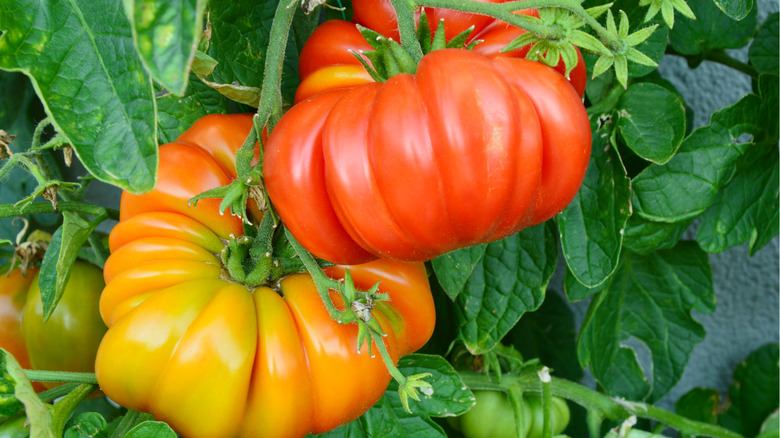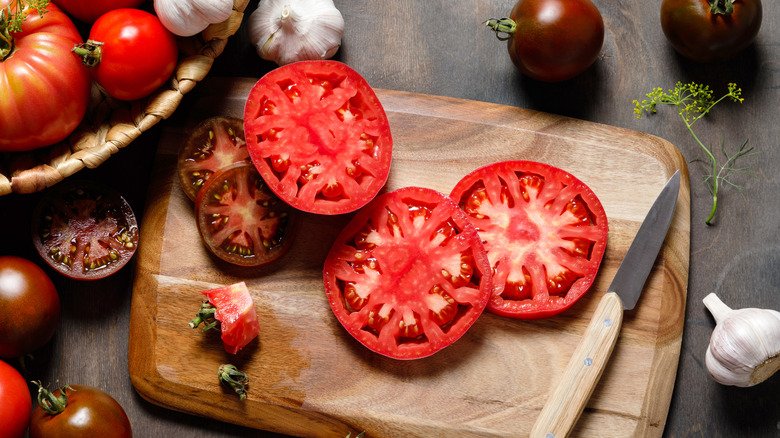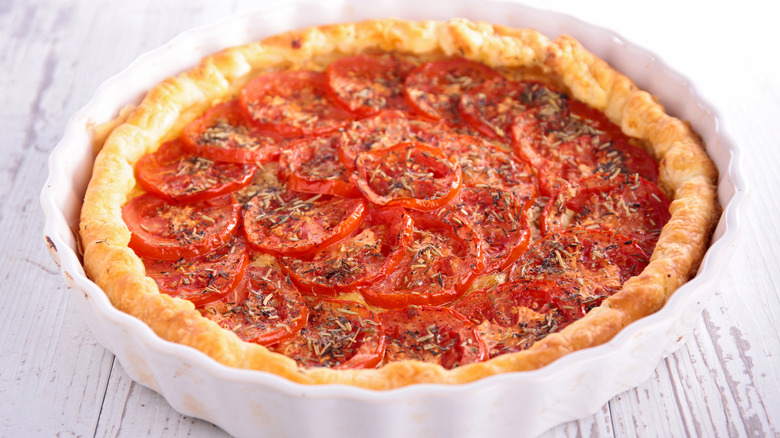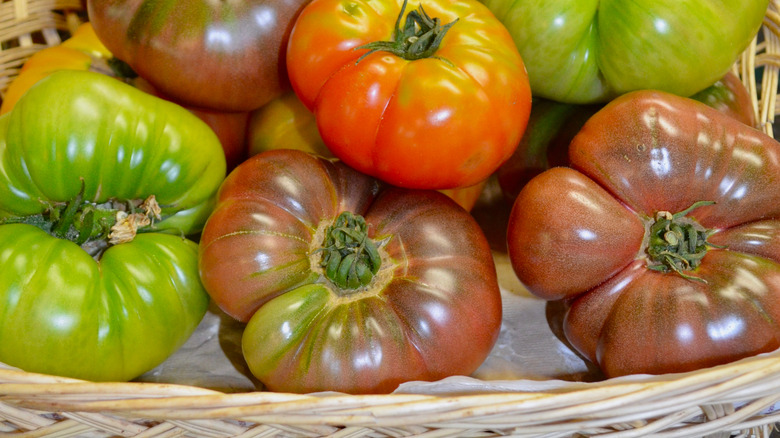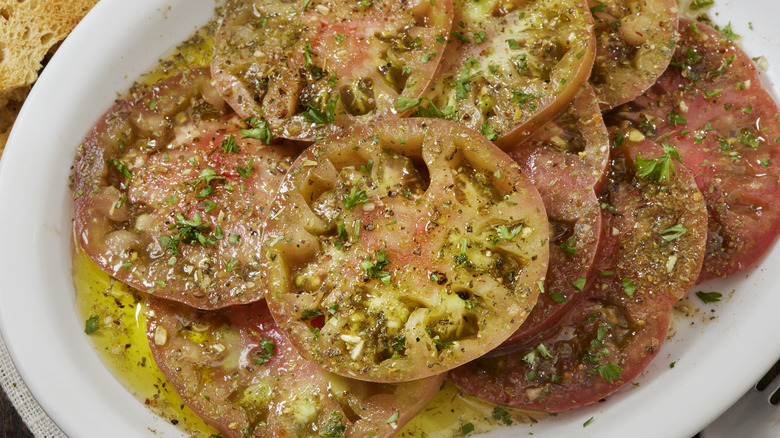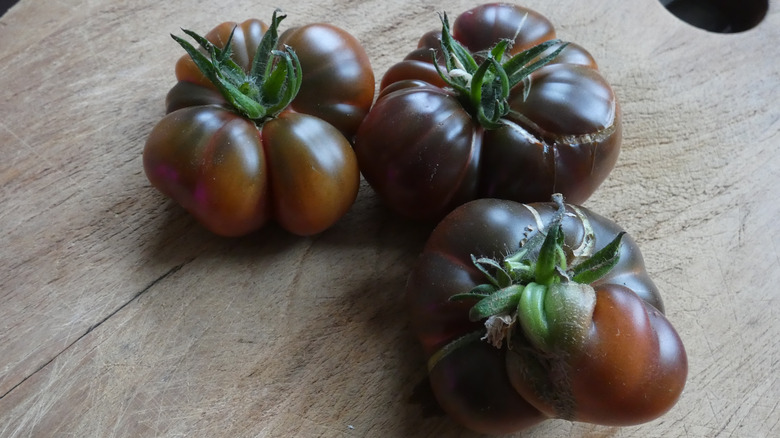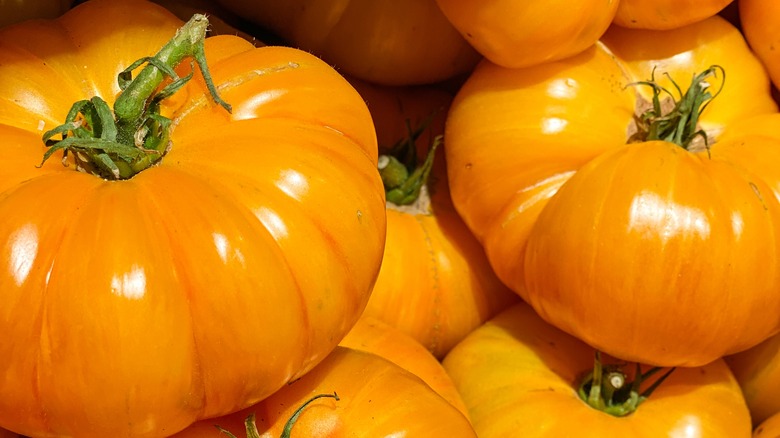What Are Brandywine Tomatoes And How Are They Best Used?
There's nothing quite like a peak-ripened, heirloom tomato that's bursting with flavor. Heirloom tomatoes are one of the most beloved crops of the late summer and early fall seasons. Among these heirloom variations is the Brandywine tomato (Solanum Lycopersicum), a large Amish heirloom that has long been prized for its sweet flavor and size. In fact, Brandywine tomatoes are so well revered in the tomato community that they are often hailed as one of the best-tasting tomatoes you can find.
Think of the Brandywine tomato as the poster child of what a good summer tomato should be. They are used as the defacto example when judging what other heirloom tomatoes should taste and look like. It's a big role to fill in the tomato world. But the Brandywine consistently holds the standard year after year. In addition to being well loved across all tomato lovers, the Brandywine tomato is simple to cultivate making it a staple of farmers markets across the U.S.
What are Brandywine tomatoes?
There is a bit of mystery around the true origins of Brandywine tomatoes. It's believed they were named after the Brandywine Creek in Pennsylvania. The tomatoes were first developed in the U.S. and were submitted to the Seed Savers Exchange in 1982. Despite their mysterious background, Brandywines quickly became one of the most popular tomato varieties. Brandywines are a member of the nightshade family, like other tomatoes, eggplants, and potatoes.
Brandywine tomatoes come in deep pink, reddish, and yellow colors. They are large in size and firm to the touch. Brandywines produce some of the largest plants of tomatoes, with their vines reaching lengths of over 10-foot long. Ripe Brandywines can come in weighing 1 to 2 pounds and have a flat, oval shape.
The Brandywine plant is known for its potato leaves, meaning the leaves on the plant look similar to potatoes. The leaves have a smooth edge, making it a clear indicator that it's a Brandywine plant. When you cut into a Brandywine you'll notice minimal seeds on the inside, a vibrant pinkish-red hue, and a sweet fragrance that accompanies its sweet flavor.
Brandywine tomatoes vs. globe tomatoes
Globe tomatoes are considered the generic tomato. They come in three different colors but are most famous for their dazzling, red shade. In comparison to Brandywines, globes are considerably smaller and more spherical. These staple tomatoes have a milder tomato flavor in comparison to Brandywines and are commonly used as sandwich toppings or diced up as toppings. Found in cans, sauces, and grocery store shelves, globe tomatoes are easy to find in all forms since they have a thicker skin that makes them easy to ship around. In comparison, Brandywines can be difficult to find as they aren't a popular commercial crop.
Brandywines have a firm texture, and are dense, with some tomatoes coming in at over a pound. The juicy, globe tomatoes weigh around 6 to 10 ounces each. Brandywines and globes are both standout stars of the tomato world, but when deciding which to use, consider how impactful you want the tomato aspect to be in your meal. If you want to center a dish around the tomato, a Brandywine would be better suited for your needs.
What do Brandywine tomatoes taste like?
As mentioned, Brandywine tomatoes are famous for their stellar tomato flavor. These tomatoes are juicy, firm, and have low acidity. This makes the Brandywine tomatoes prized for things such as tomato salads, tomato pies, and tomato sandwiches. Brandywine tomatoes are very balanced in flavor, creating a perfect mixture of sweet, bitter, sour, and a hint of earthiness when eaten uncooked. When you bite into a Brandywine tomato you'll be met with a surprising melt-in-your-mouth quality to the tomato that highlights the richness of flavor.
When Brandywine tomatoes are cooked the sweet flavor is brought out, cooking caramelizes the tomatoes and produces a rich, deep sweetness. Cooking Brandywines enhances the flavor profile of the tomatoes as it cooks out any additional liquid content, which can normally water down the flavor. This may require cooking your heirlooms for up to three hours to get the best results. The lighter the Brandywine tomato is in shade the more sour flavor notes you'll get from the fruit. If you want a deeper tomato flavor, choose one that is darker in color.
How to cook with Brandywine tomatoes
Brandywine tomatoes can be enjoyed cooked or raw and have a multitude of uses in both forms. Enjoy raw, sliced Brandywine tomatoes on toast with a light spread of mayo, or in BLT sandwiches. If you choose to serve Brandywines raw, it's recommended to top the tomato slices with a pinch of salt. This balances the flavors of the tomato and enhances that famous sweetness Brandywines are known for. Brandywine tomatoes are large, so however you choose to serve them it's best to make them the focus ingredient to highlight their beautiful flavor and appearance.
If you choose to cook Brandywine tomatoes, you can make a beautifully sweet tomato sauce or soup. If you cook Brandywine tomatoes, be prepared to cook them slightly longer than other tomatoes since they take a bit longer to soften. Like other cooked tomato recipes you'll want to peel the skin of the tomato at some point for a silky, smooth texture in your sauces and soups. Brandywine tomatoes can also be artfully arranged and baked into a tomato pie or tart.
Where to buy Brandywine tomatoes
Brandy tomatoes can most commonly be found at your local farmers market, in small produce stands, or grown in your own backyard. They are less commonly found in grocery stores as they are not typically a large commercial crop. Heirloom tomatoes, such as the Brandywine, are typically a popular produce during the late summer and early fall months. Be sure to ask your local vendors about Brandywine tomatoes and they should be more than happy to point you in the right direction.
Occasionally you can find Brandywine tomatoes in your local grocery store. To ensure you're getting Brandywine tomatoes and not another variation, try to look at the leaves of the tomato if they are still attached. As mentioned, Brandywine tomatoes have smooth leaves, similar to potato leaves. Typical tomato plants will have serrated leaves, with rigid edges. Looking at the leaves can ensure you buy the right tomato. You can also identify Brandywine tomatoes based on their larger size.
Nutritional information about Brandywine tomatoes
Brandywine tomatoes are packed with the antioxidant lycopene, which is important for protection against free radicals in the body. According to LiveScience, this can prevent things such as heart disease and cancer. Antioxidants are also important for eye health. Brandywine tomatoes have high amounts of vitamin A, vitamin C, potassium, and fiber, all of which contribute to the functioning of your body. Heirloom tomatoes in general are a powerful source of vitamin C, with one tomato providing you 40% of your daily value.
Brandywine tomatoes are low in sugar and calories. They come in at about 35 calories per 100 grams of Brandywine tomatoes. The Brandywine tomato is fat-free, making it an ideal main ingredient in dishes if you're looking for healthy, delicious substitutes. Heirloom tomatoes also contain folate, which, according to Mayo Clinic, promotes healthy cell growth and function.
Varieties of Brandywine tomatoes
Brandywine tomatoes are their own variation of heirloom tomatoes to begin with, so while there is no distinct offset of Brandywine tomatoes, they can come in a beautiful range of colors that can impact their taste. Color can be an indicator of how ripe a Brandywine tomato is. Darker tomatoes are typically more sweet, and tender. Lighter-colored Brandywine tomatoes are usually firmer to the touch and have a tangier taste to them.
Brandywine tomatoes have a rainbow of appearances. There are pink, red, yellow, apricot, purple, black, and cherry Brandywine colors. There is also a trend among the darker colors to be slightly smaller than the lighter colors, and to have a lightly spicy flavor to them. Surprisingly, Yellow Brandywine tomatoes come in at the heaviest, reaching almost 800 grams at times. In comparison, Red Brandywine tomatoes are the lightest, typically reaching 250 grams.
How to store Brandywine tomatoes
It's recommended to store Brandywine tomatoes in a cool, dry environment. If you have Brandywine tomatoes that haven't reached full ripeness yet you can leave them in a lightly sunlit environment while they reach full blush. After your tomatoes ripen, avoid putting them in direct sunlight. Brandywine tomatoes, like other tomatoes, should be kept between 55 and 70 degrees Fahrenheit, and colder or warmer will impact the quality of the tomato.
If your tomatoes are whole, you can skip refrigerating them. If you put them in the fridge they can lose some of their potency. Putting whole tomatoes in the fridge chemically changes the tomatoes and causes a mushy texture. After you cut your tomatoes they'll have to be stored in the fridge. Either wrap the cut pieces in a tight plastic wrap or keep them in a sealed plastic container or bag. It's recommended to use cut tomatoes within a few days for the best quality and taste.
You can opt to freeze your tomatoes for up to six months. However, freezing Brandywines does diminish the texture; they become more watery and aren't ideal to be enjoyed on their own. Frozen tomatoes are best used in soups, stews, and casseroles.
